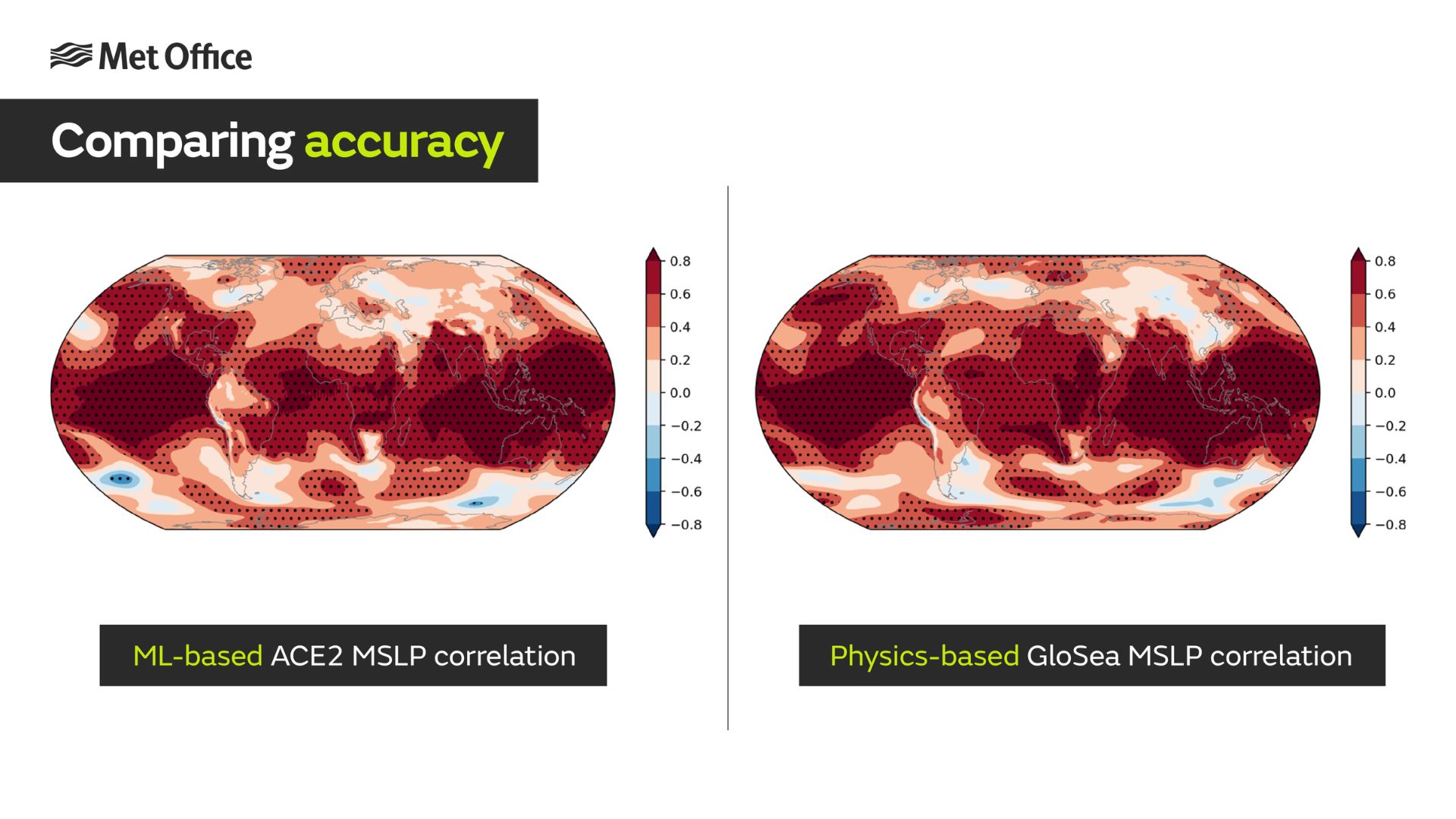Machine Learning model demonstrates promising seasonal forecasting capability
Author: Press Office
10:02 (UTC+1) on Thu 4 Sep 2025
Machine Learning-based weather models have the potential to revolutionise global seasonal forecasting, according to new Met Office-led research.
The peer-reviewed research, published in npj Climate and Atmospheric Science, assesses the viability of applying a machine learning (ML) weather model to global seasonal forecasts, which are vital for understanding global weather patterns.
Seasonal forecasts, which look at the likely conditions for the next three months, can provide valuable insights for long-term planning and decision making, including for agriculture, water resources and even public health.
Existing methods to provide seasonal forecasts involve running physics-based models multiple times to understand the most likely scenarios, with probabilities applied to different conditions. Met Office seasonal forecasts are currently among the world’s best, providing clarity on potential scenarios for the weather months ahead.
According to new HCCP-funded research, the Allen Institute for AI (Ai2)’s ML model, known as ACE2, demonstrates comparable (though lower) performance to existing methods, with significantly less computing power required.
Met Office Lead Author and Senior Scientist Chris Kent said: “We’ve already seen how ML-based approaches show skill in short-range forecasting, what this paper does is explore using these methods at a much longer timescale at a global level.
“We’ve found that ACE2 shows skill comparable to existing physics-based methods, which could open up new opportunities on generating more detailed and accurate forecasts at a seasonal range.”
Minister for AI and Digital Government Feryal Clark said: “This research underlines the UK’s global leadership in bringing together cutting-edge AI and world-class meteorological science.
“By improving our ability to forecast weather months in advance, we can help provide businesses and public services the information they need to plan ahead with more confidence. From supporting crop decisions to helping the NHS prepare for winter, this work shows how emerging technologies like AI can drive growth, strengthen resilience, and improve people’s everyday lives as part of our Plan for Change.”
Comparing accuracy
In order to assess the accuracy of ACE2’s seasonal predictions, an ensemble of global forecasts covering 23 Northern Hemisphere winters was compared to both physics-based predictions for the same period, as well as the reality of the observed conditions that we know took place.
The ensemble spread was similar to existing methods, with skilful predictions of the North Atlantic Oscillation, which often affects weather conditions in Europe and North America. When predicting the wintertime North Atlantic Oscillation, correlation scores of 0.3 – 0.6 are typically seen across physics-based models, whilst ACE2 achieves a score just under 0.5. In this methodology, a score of 1 would demonstrate perfect accuracy to the observed conditions.
However, varied levels of skill were demonstrated in different locations across the globe, and in general the ML-based model did not yet outperform the existing physics-based methodology.

Figure: The above maps show the correlation of ML-based ACE2 (left) and physics-based GloSea (right) models to the observed conditions over 23 northern hemisphere winters from 1993/94 to 2015/16. The deeper reds indicate higher levels of accuracy, and the blues lower level of accuracy.
Predicting extremes
Despite demonstrating potential for winter predictions, the research also underlines potential limitations of solely relying on ML-based seasonal forecasts.
The 2009/10 winter was particularly cold, with a record negative North Atlantic Oscillation and the eighth coldest winter on record for the UK in a series which dates back to 1884.
Paper co-author and the Met Office’s Head of Long-Range Forecasting Adam Scaife explained: “We also found that the ML model struggled to predict conditions beyond the training data. 2009/10 was an exceptional winter and is a key test case for predictions but without the underpinning physics of conventional models, the ML-based solutions struggled to predict this more extreme case.”
“It’s going to be important to leverage the benefits of these fast ML-based models for accelerated improvements to seasonal forecasting, while still being underpinned by physics-based understanding of the atmosphere.”
Next steps
This proof-of-concept study is another step on the way to the next generation of weather forecasting and highlights the Met Office’s ongoing innovative approach to enhancing the power of weather intelligence.
Lead Research Scientist for Climate Modelling at Ai2 Oliver Watt-Meyer said: “It is an exciting moment for machine learning in earth science as we move beyond medium range weather to seasonal and longer time scales. Importantly, it will be necessary to stop solely predicting atmospheric conditions and start including the ocean and other components of the climate system.”
Collaboration will remain key to realising the full benefits of AI modelling for weather prediction. Further research is still required to better understand opportunities and limitations, with the Met Office aiming to bring through both short and long-term forecasting improvements in a safe and reliable way by fusing together the combined strengths of physics and AI/ML-based forecasts.
Find out more about AI and the Met Office.





